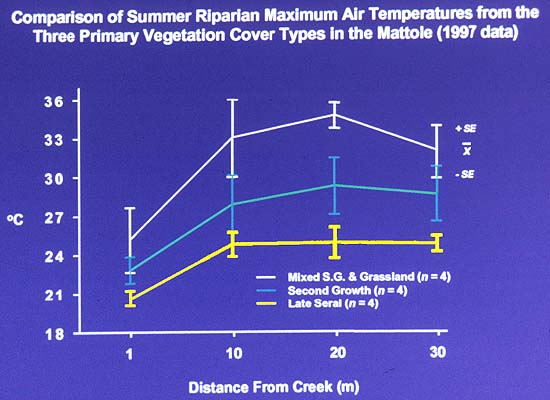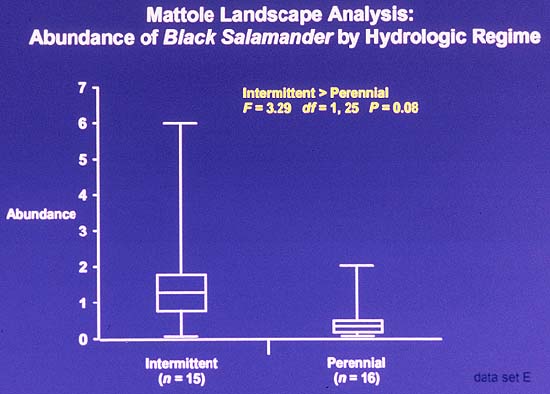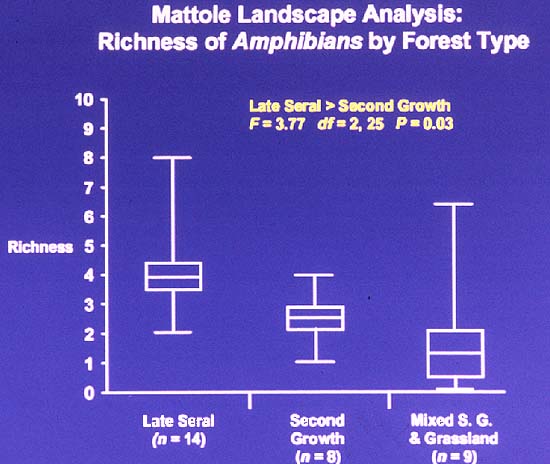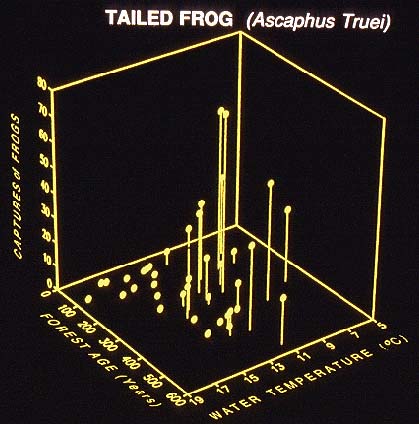Bibliography Background About KRIS
Relationships between forest types, temperature and amphibians
Range of riparian air temperatures as a function of distance from streamside in three forest types of the Mattole watershed
The range of water and air temperatures relative to distance from the stream in three different forest habitats is shown in this graph. Maximum summer air temperatures are much higher in mixed second growth and grassland and in second growth forests than in late seral forests. This in turn causes increases in water temperatures. Water temperatures in streams under late seral forest canopies generally range between 10-14 degrees C which is optimal for tailed frogs, torrent salamanders and coho salmon. See Riparian Conditions for more information on this topic.
Source: H. Welsh, U.S.F.S. - PSW Redwood Sciences Lab, Arcata, CA
Abundance of Black Salamanders in Perennial and Intermittent Streams
Recent studies of headwater streams in the Mattole River basin showed that intermittent streams are very important for black salamanders. The high density was in part owing to high numbers of juveniles, suggesting that intermittent reaches may be very important for rearing areas for this species. Data provided by the H. Welsh, USFS PSW Redwood Sciences Lab in Arcata, California.
Source: H. Welsh, U.S.F.S. - PSW Redwood Sciences Lab, Arcata, CA
Richness of amphibian species in three forest types
This graph shows that late seral forests (old growth) contain significantly more amphibian species than either second growth or mixed second growth and grassland. At half the 14 sites in late seral forests, an average of three and a half to four and a half species were found. In second growth, half of the 8 sites had between two and three species, while in mixed second growth and grassland, half the 9 sites had an average of about one half to two species. Data is from research conducted by the herpetology group at the USFS Redwood Sciences Lab.
Source: H. Welsh, U.S.F.S. - PSW Redwood Sciences Lab, Arcata, CA
Relationship between forest age, water temperature and abundance of tailed-frogs
Tailed frogs are most abundant in old growth forests, where water temperatures remain cool. Note that few frogs were found in forests less than 100 years old, or in forests older than 100 years where water temperatures rise above 15 degrees C. Tailed frog eggs cannot survive temperatures in excess of 18.5 degrees, and this temperature may be attained if forest canopy is removed through logging. Data are from H. Welsh, U.S.F.S. - PSW, Redwood Sciences Lab, Arcata, CA.

Amount of canopy and abundance of southern torrent salamander
The southern torrent salamander must have cool, shaded habitat. As this graph shows, almost all the sites with this salamander present had canopy cover over the stream of at least 80%. The juvenile torrent salamander resides in streams and becomes stressed at temperatures greater than 17.2 degrees C. When riparian canopy is removed through logging activity, water temperatures often rise above thresholds for this species.
Source: H. Welsh, U.S.F.S. - PSW Redwood Sciences Lab, Arcata, CA
